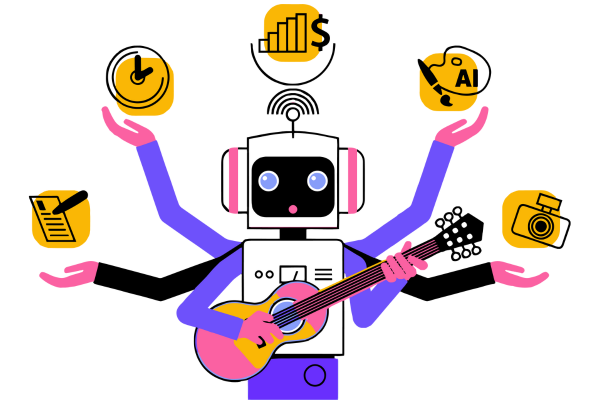AI in Creative Arts: The Future of Music, Art, and Writing
Category: AI Revolution
Introduction:
Data analysis and robotics are no longer the only applications of artificial intelligence (AI). It has now permeated the creative sphere, impacting the conception and experience of literature, music, and art. AI is revolutionising the creative sectors by providing writers, musicians, and artists with new tools to push limits, develop, and work together like never before.
How AI is Revolutionizing the Arts:
1. AI in Visual Art:
Our understanding of creativity is changing due to AI-generated art. Programs like DALL·E, MidJourney, and DeepArt allow artists to express their ideas verbally and produce breathtaking images. These platforms create art that frequently rivals human inventiveness using deep learning algorithms.
For example, discussions over the use of AI in art were sparked in 2022 when the AI-generated piece "Théâtre D'opéra Spatial" took first place at the Colorado State Fair's digital art competition. AI also aids in the restoration of historical artwork, technique analysis, and even the creation of new styles through inspiration from masterworks already in existence. In addition to a means of accelerating their creative processes, artists now have access to an infinite source of inspiration.
2. AI in Music Composition
AI has evolved into a composer in its own right, creating everything from symphonies to catchy pop songs. With the use of programs like Amper Music and AIVA (Artificial Intelligence Virtual Artist), musicians can compose music that is suited to particular genres or moods.
As an illustration of how AI may imitate human emotions in music, AIVA composed the classical music album Genesis in 2016.
AI is a useful tool for both experts and novices since it can also be used for audio mastering, remixing, and sound quality enhancement.
3. AI in Creative Writing:
Storytelling is being revolutionised by AI writing tools such as ChatGPT and Jasper AI. They help authors by coming up with tale ideas, proposing plots, or even writing whole stories. Novelists, screenwriters, and content producers who want to expedite their work or get past writer's block will find these tools especially helpful.
For instance, in 2020, an AI published an opinion piece for The Guardian in which it persuasively argued that robots pose no threat to humankind. This demonstrated AI's potential for opinion and journalistic writing.
AI is also being used to analyse audience preferences, which helps authors create material that is more impactful and engaging.
The Future of AI in Creative Arts:
AI's incorporation into writing, music, and art is continually developing. Future developments might result in highly customised creative experiences, like interactive AI-generated novels that adjust to the tastes of the reader or virtual reality concerts including music written by AI.
Even with these options, nothing will ever replace the human touch. While AI is capable of imitating patterns, genuine art is characterised by its innate human emotional depth and cultural subtleties.
Conclusion:
AI in the creative arts aims to empower people rather than replace them. It offers resources for redefining artistic expressions, breaking down barriers to creativity, and exploring new possibilities. The difficulty in adopting this technology is striking a balance between creativity and genuineness.
A future where literature, music, and art are more dynamic, inclusive, and accessible than ever before is promised by the combination of human creativity and AI capabilities.
